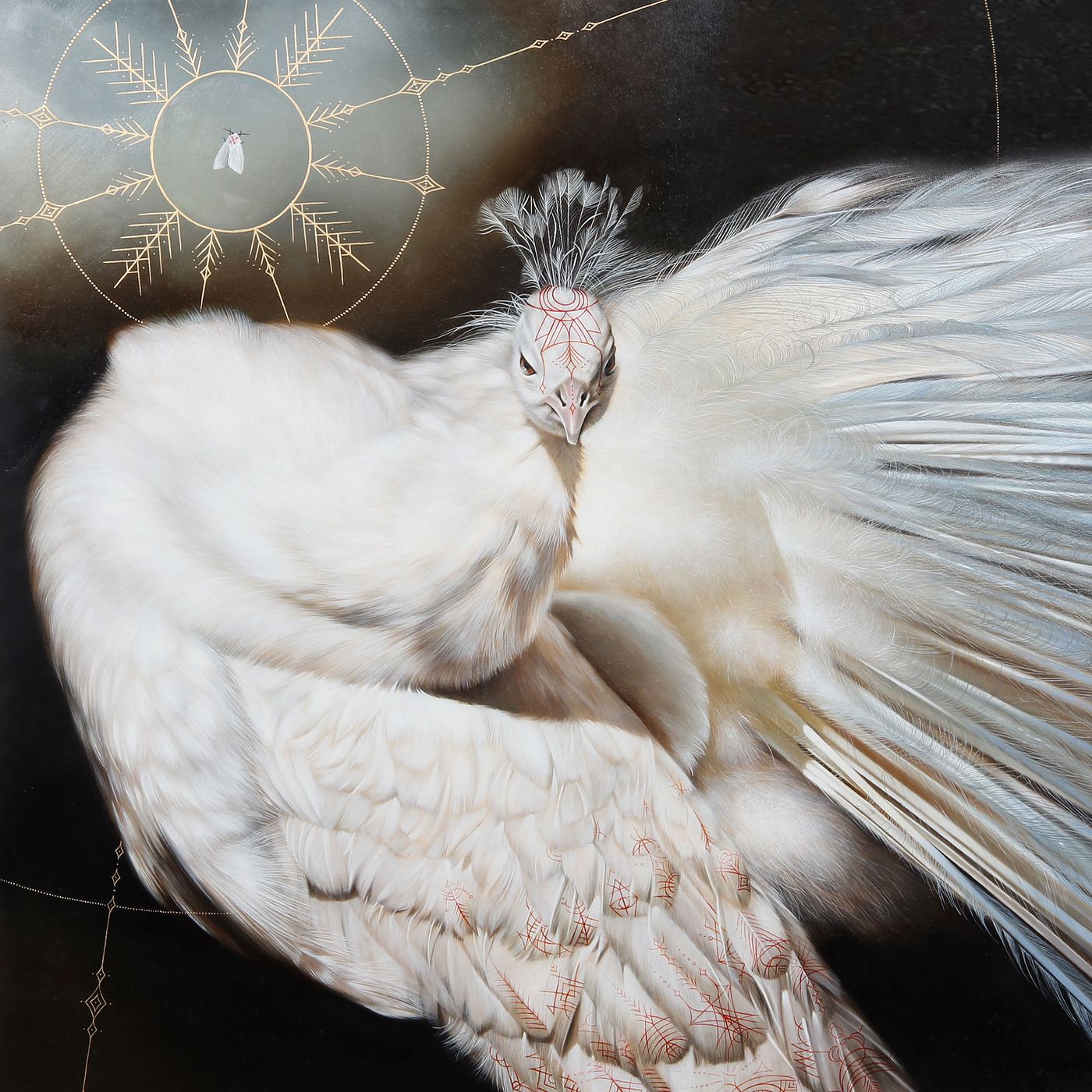
The Mystical Iconography of Josie Morway's Hyperrealistic Paintings
Words by Eric David
Location
The Mystical Iconography of Josie Morway's Hyperrealistic Paintings
Words by Eric David
Self-taught American artist Josie Morway’s hyperrealist paintings immediately enchant the viewer with their brooding sensibility and mystical ambience. Often featuring exotic birds and other wildlife in stylized poses intertwined with lush vegetation and adorned with cryptic symbols, mysterious drips and obscure Latin texts, Morway’s work references religious paintings with the animals standing in for saints, an ecclesiastical allusion that is enhanced by her use of oils and enamels on wood instead of canvas. With a steady hand for hyperrealism, where every feather, petal and leaf is rendered in excruciating detail, and an eye for intricate, Daliesque compositions, her paintings are underpinned by a stylistic dissonance between narrative realism and uncanny surrealism that raises more questions than it answers. Yatzer talked with the artist about her recent paintings, her practice and her passion for wildlife.
(Answers have been condensed and edited for clarity.)
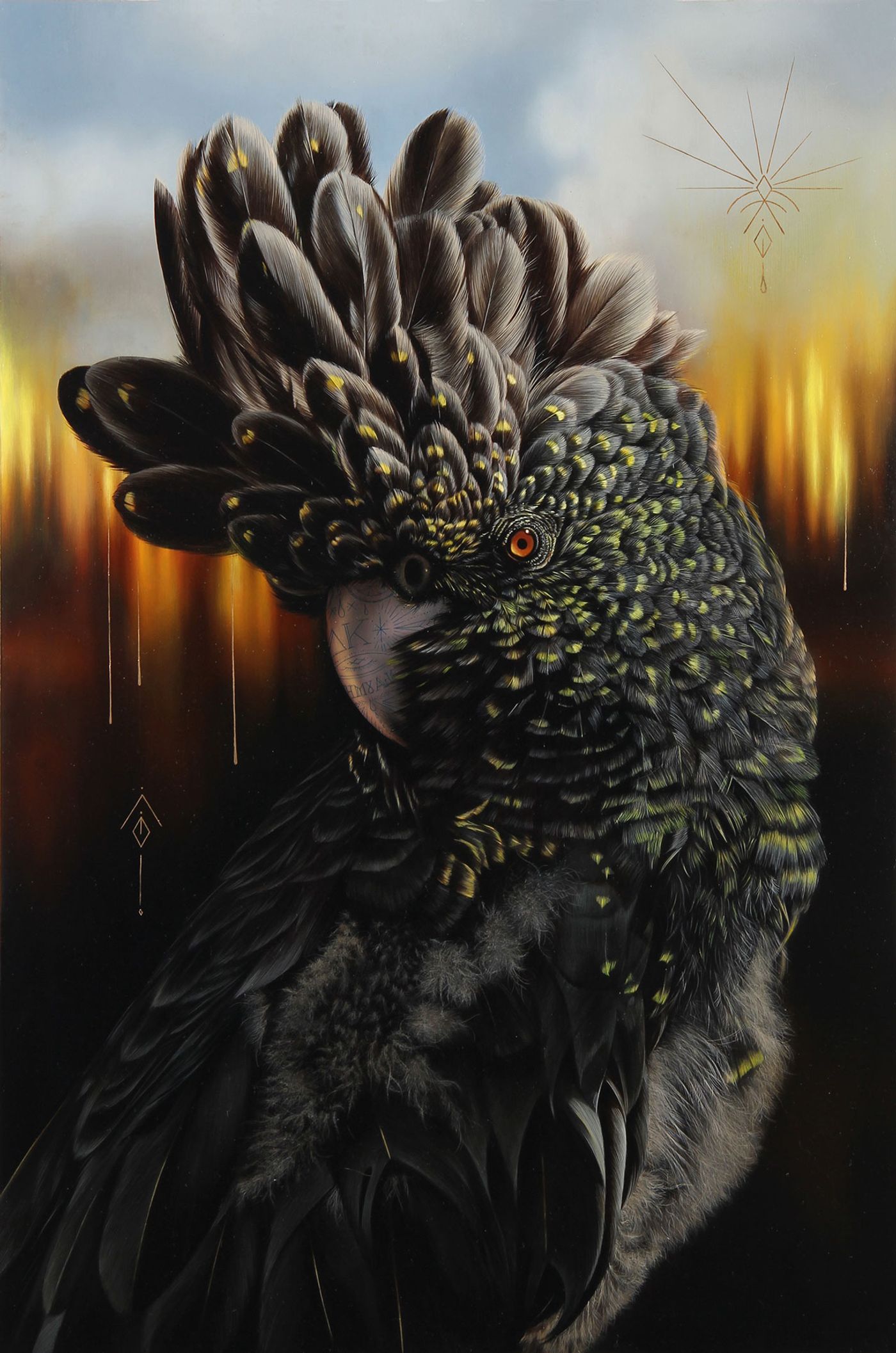
Josie Morway, Consumed, oil and enamel on wood panel. © Josie Morway.
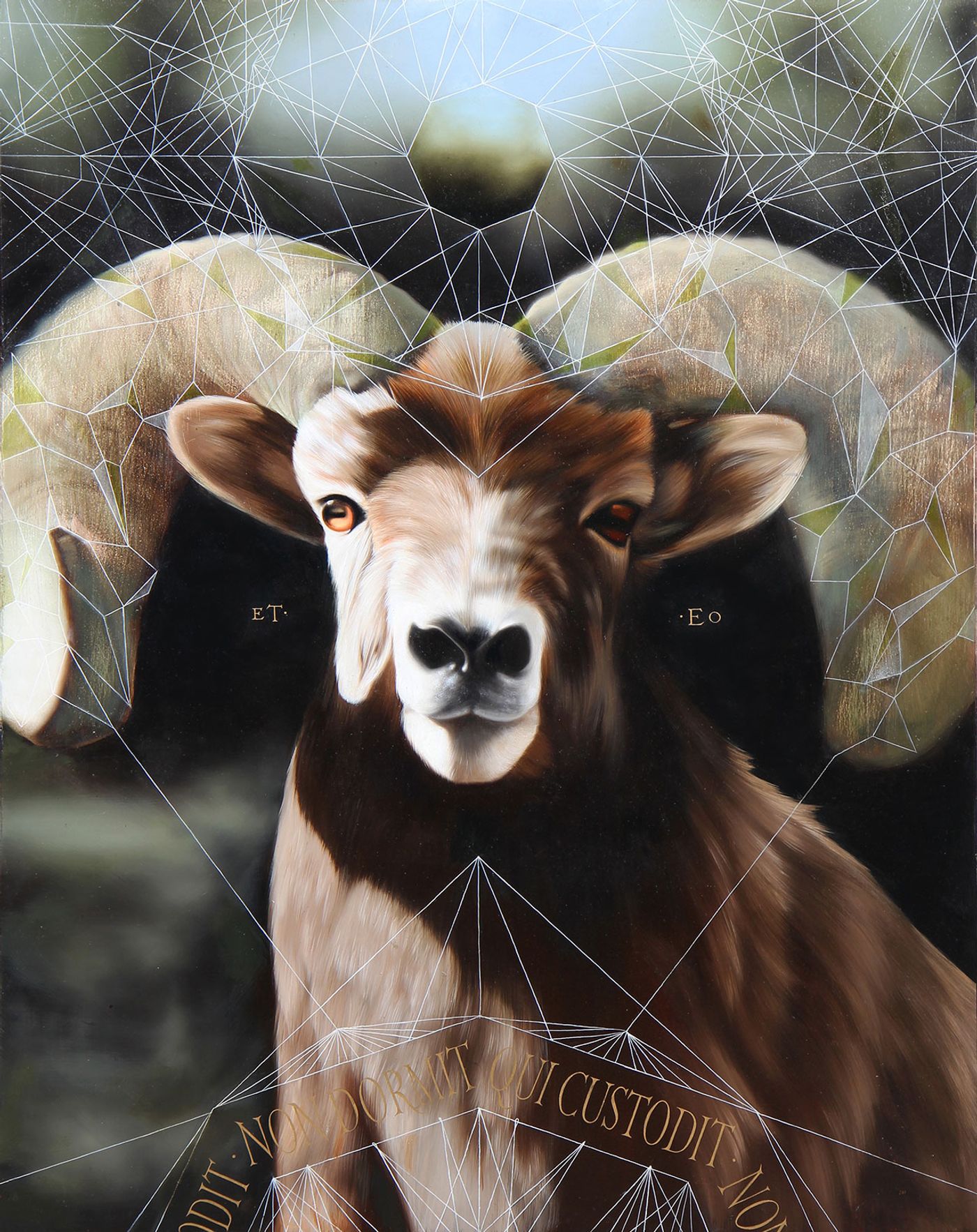
Josie Morway, Bighorn, oil and enamel on wood panel. © Josie Morway.
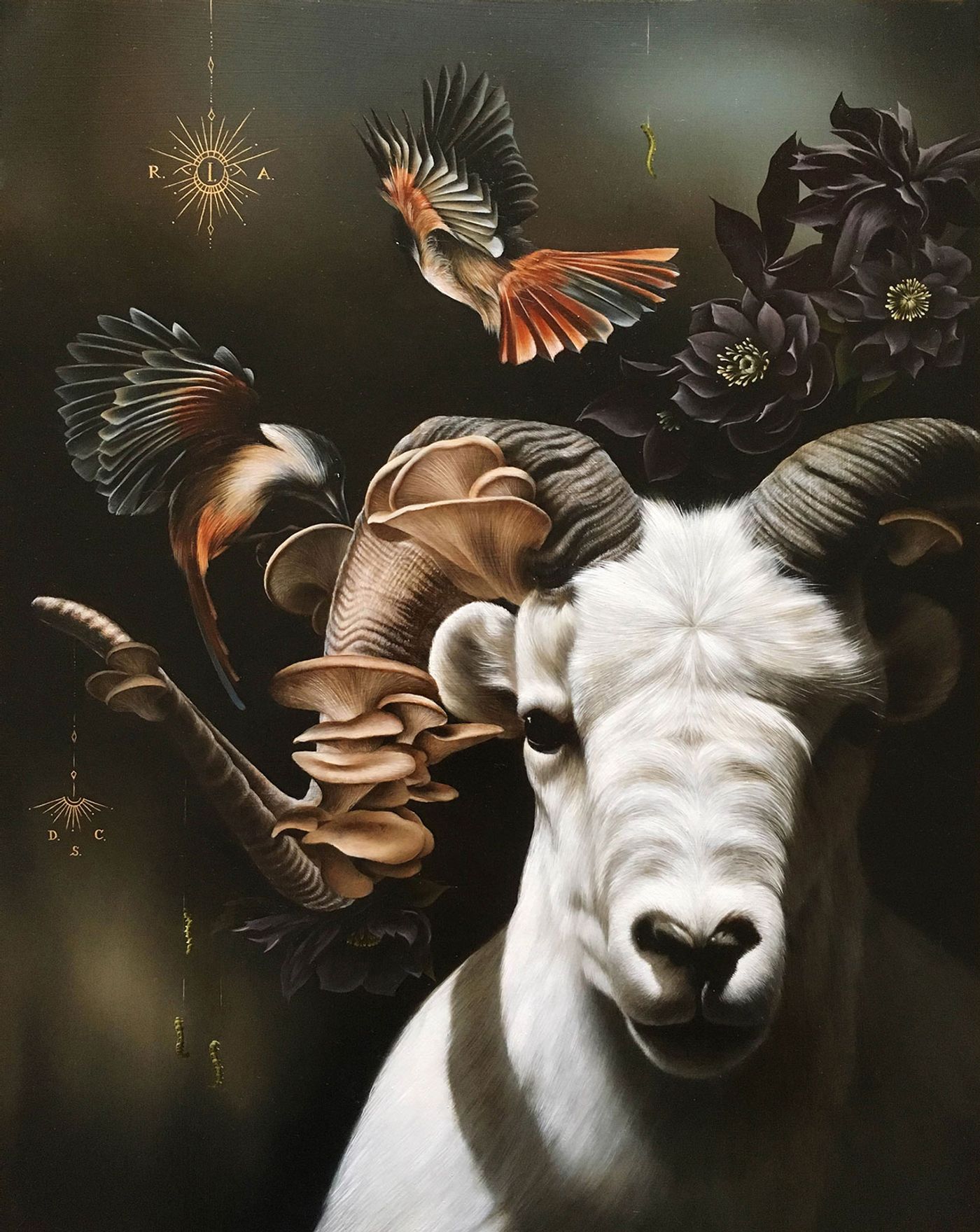
Josie Morway, Decay, oil and enamel on wood panel. © Josie Morway.
What inspired you to become an artist? Did you draw or paint as you were growing up?
I've certainly drawn and painted for as long as I can remember, and I'm lucky that I had parents who encouraged it. That said, I never really planned to become a painter. I've pursued so many other careers, wanted to be a writer, a linguist, an environmental scientist... and yet even while I was working at those other things I was always "stealing" time to paint. I once read some advice to writers which I'd paraphrase basically as "don't be a writer unless you have absolutely no choice". That's how I feel about painting; it's the thing I have to do even though I've tried not to.
Your recent works impress with their visceral hyperrealism, mystical sensibility and romantic undertones. How did the series evolve? What are you trying to convey or express?
Well thank you! Your adjectives are definitely among those I'm aiming for. My work has definitely been evolving steadily for years and years now, so sometimes it's hard for me to explain exactly where and when things have emerged. The hyperrealism, like painting itself, is just something I can't resist. I have a hand and a mind that's well suited to being meticulous and time-intensive. The more mystical vibes have emerged as a way to let go of straight realism and trust my gut more and more, sort of like moving towards poetry and letting go of editorial prose.What I'm trying to convey can vary from piece to piece, but overall I'm trying to create work that shows a reverence for wildlife, while also respecting its ultimate unknowability. I want to keep some mystery and even discomfort central to the work, as a reminder that we need to respect nature without ever fully speaking its language.
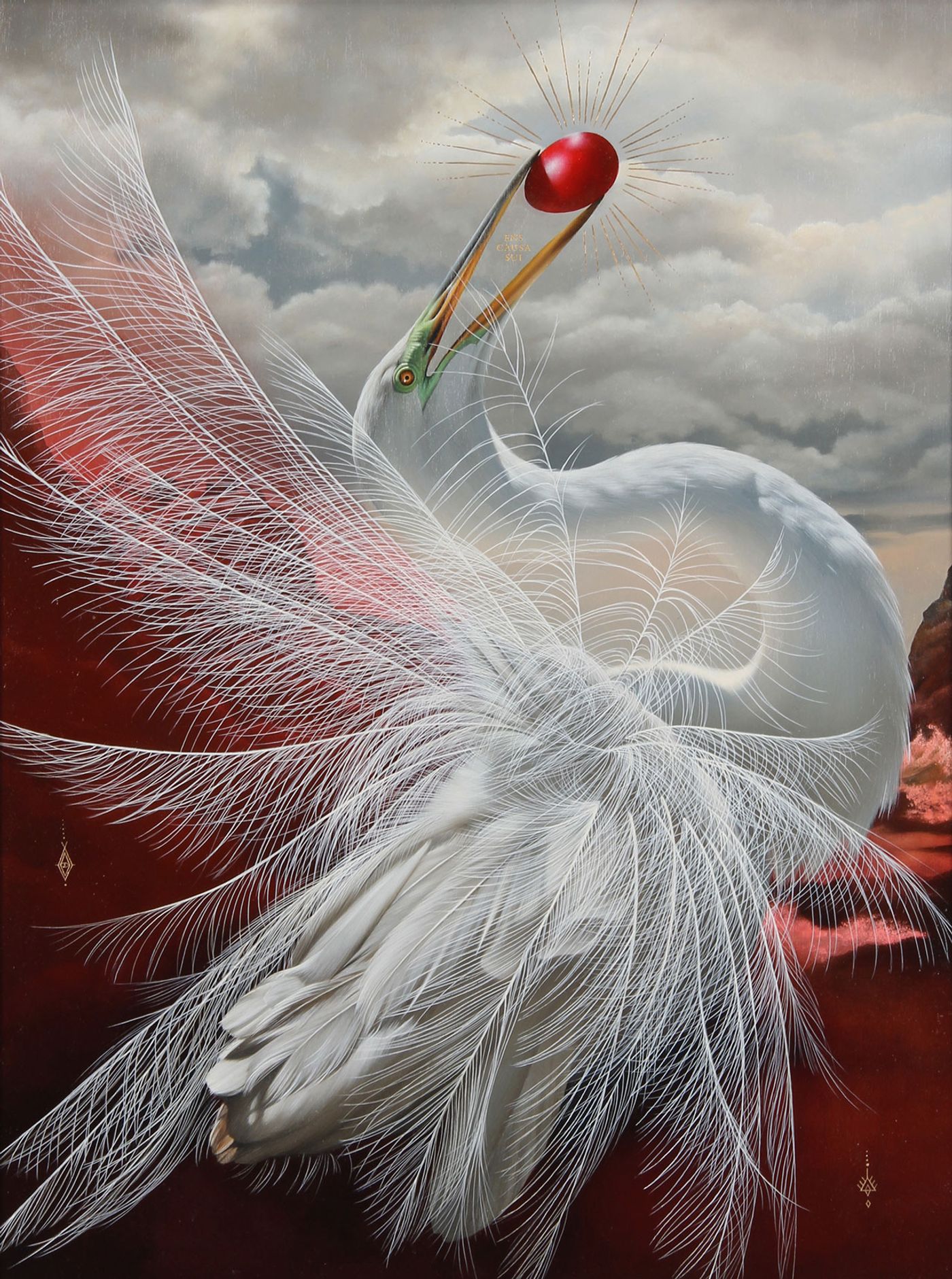
Josie Morway, Bioremediators, oil and enamel on wood panel. © Josie Morway.
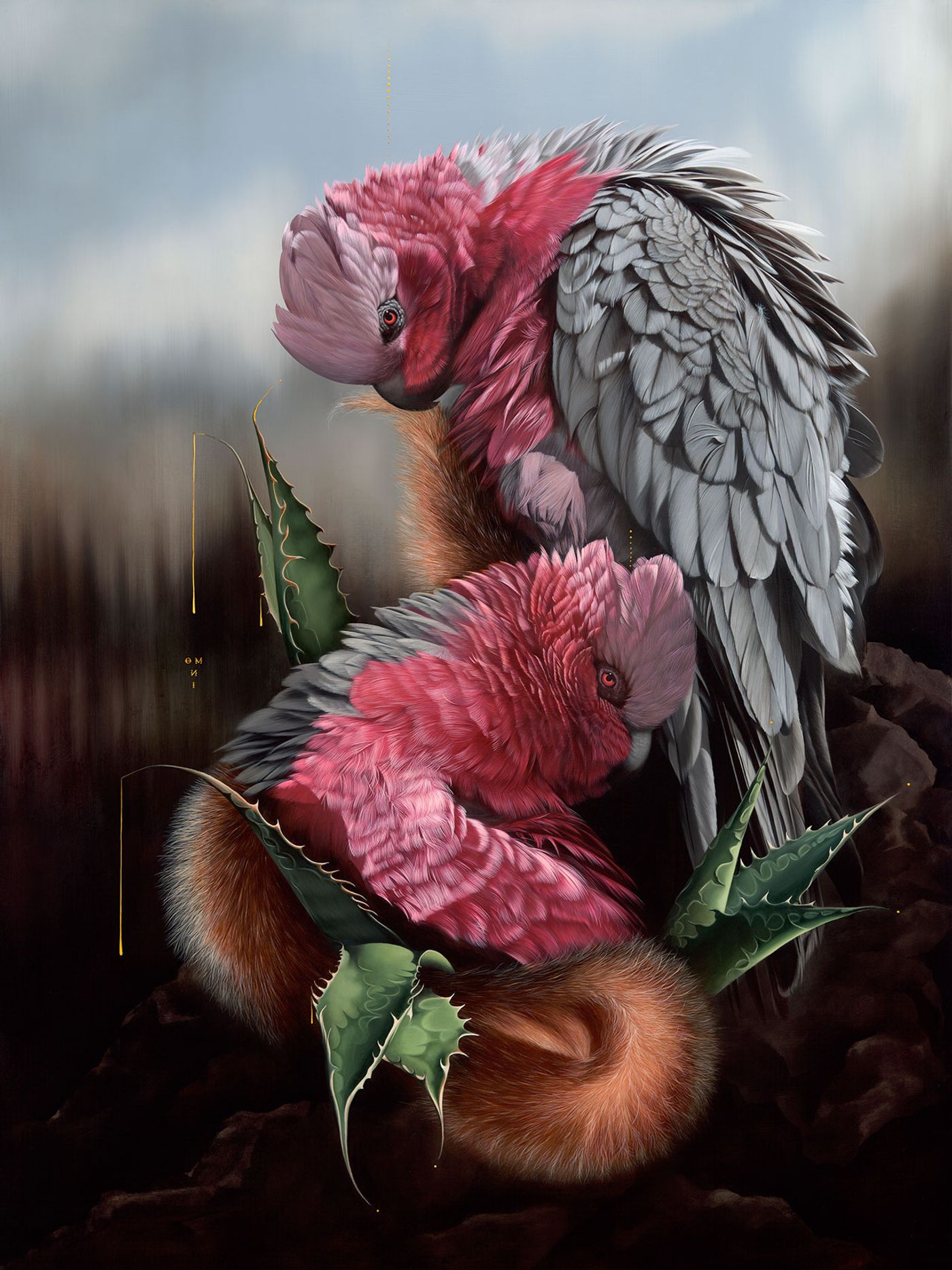
Josie Morway, Fortify, oil and enamel on wood panel. © Josie Morway.
Wildlife and especially birds are predominantly featured in your work whereas people are wholly absent. Why is that? Where does your fascination with birds in particular stem from?
I've always had a feeling of awe and empathy for animals and nature that tends to veer towards sadness due to their vulnerability, the way they suffer at our hands, or at least our inattention. I think in some ways my work is an attempt to counter that sadness by taking an animal—a small bird for example—and rendering it epic, larger than life, vivid, immortal and invulnerable, much in the way painters once paid tribute to saints. In this way my animals become hopeful totems of a sort.
There's definitely a long-standing tradition of birds and animals in art, and often the wildlife stands in as a sort of allegory for human stories or concerns. There's definitely something of this in what I do too but at the same time I don't like this anthropocentric idea of animals as only vehicles for human stories, so I'm trying to create work that keeps the viewer a little bit off of their guard.
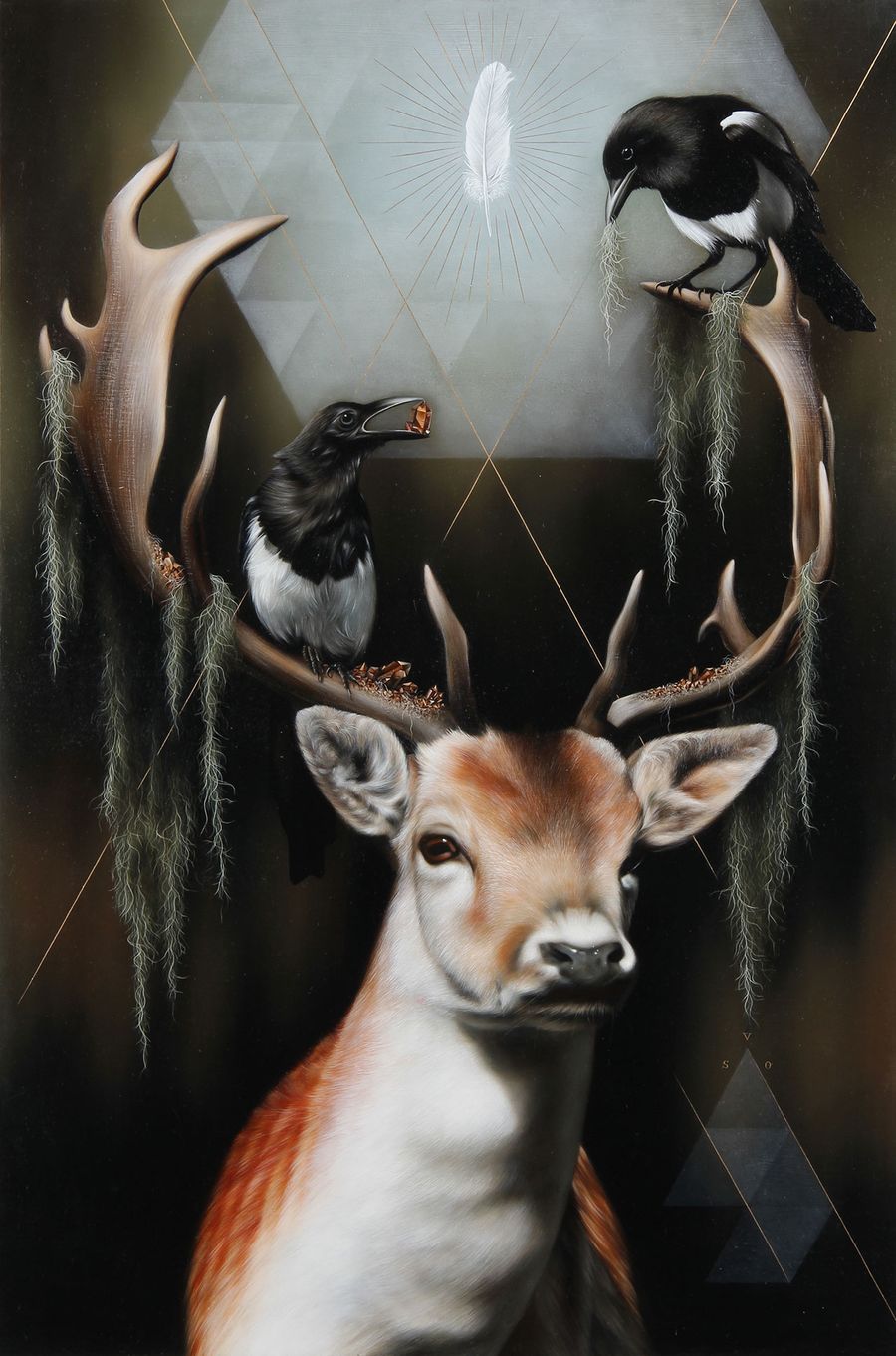
Josie Morway, Sero, oil and enamel on wood panel. © Josie Morway.
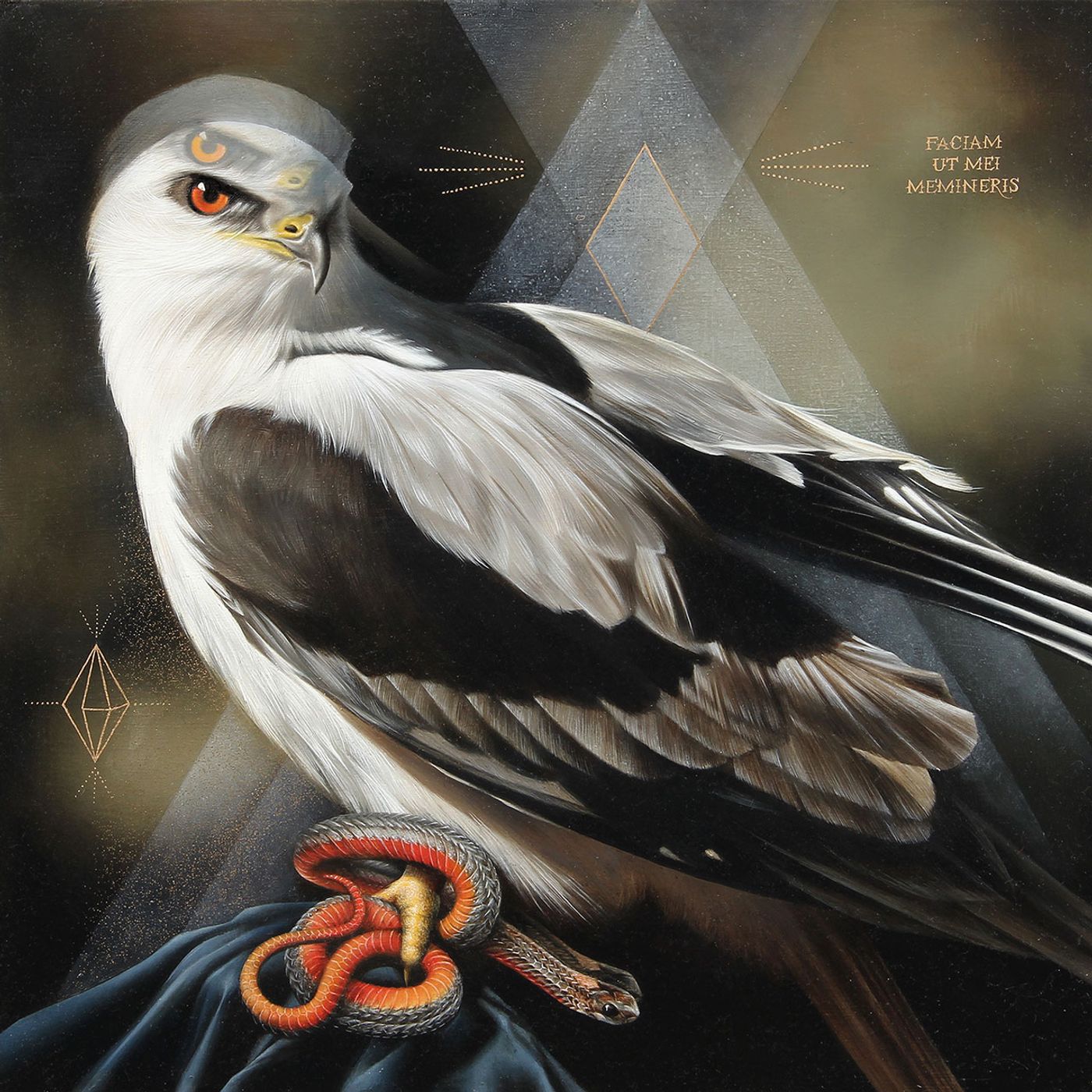
Josie Morway, Faciam, oil and enamel on wood panel. © Josie Morway.
There seems to be a poetic juxtaposition between the birds’ feathers and the plants’ leaves which are frequently interlaced. Is this more of an aesthetic flourish or are there some conceptual underpinnings?
While I work intuitively, I don't think that anything I do is purely aesthetic. The "interlacing" you mention is right at the heart of what I'm thinking about with the botanicals in my work. I'm hoping to suggest interconnectedness, the way that we're all entangled and interdependent, thus the name "Symbiotes" for a few of my recent plant/bird combos. I'm enjoying making somewhat confusing compositions, where it's hard to tell whether the bird is consuming or is being consumed by the plant. This brings me back to my fascination with humans' ability to misinterpret nature, which I can't resist playing with, making imagery that's a bit uncomfortable or hard to interpret.
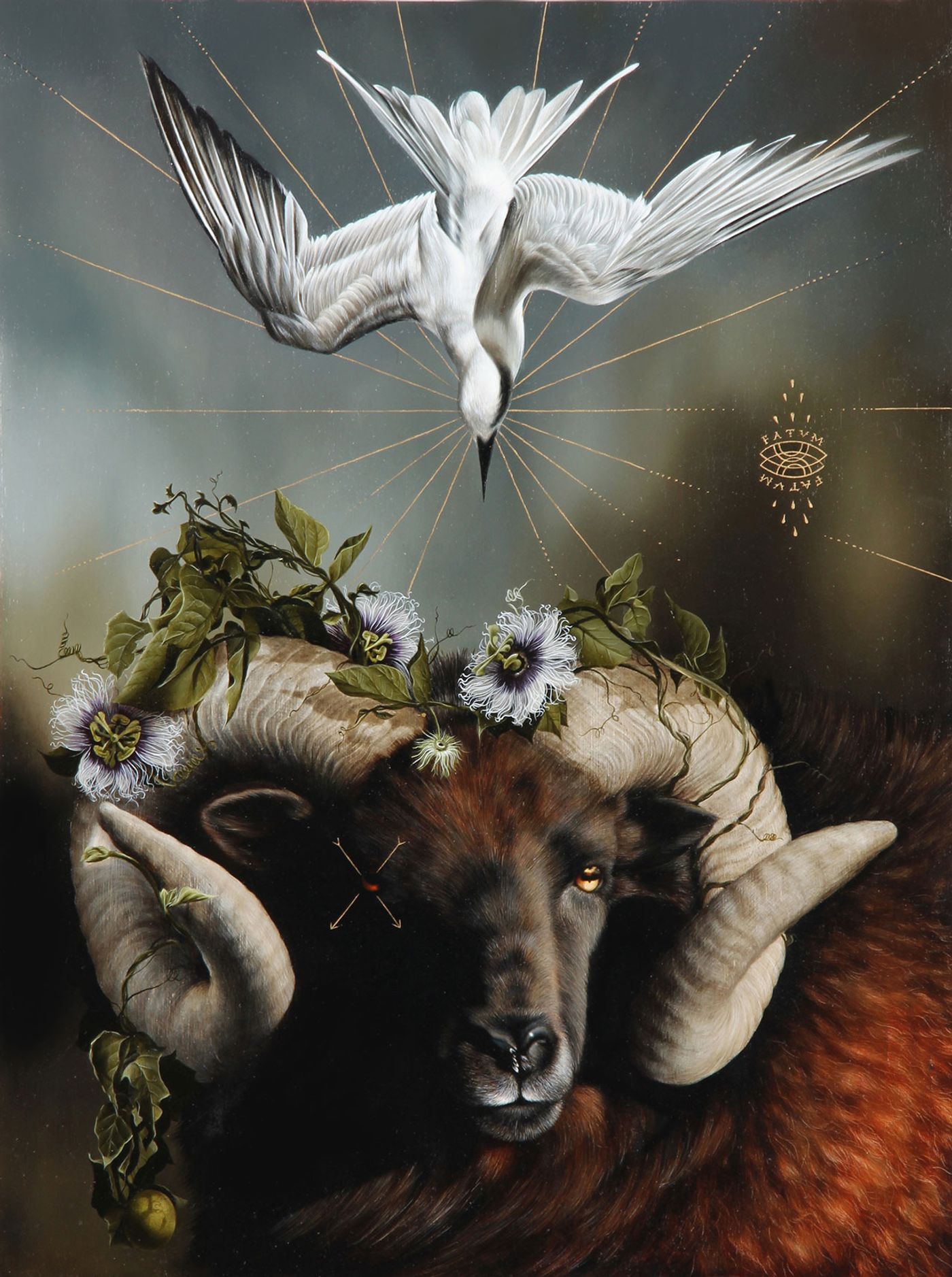
Josie Morway, Fatum, oil and enamel on wood panel. © Josie Morway.
Do you paint by imagination and memory or do you rely on photographs? What are your criteria for choosing the animals you portray?
I definitely rely on photographs, and spend as much time exploring reference materials as I do painting. I sketch from books, photos I find online and photos I take myself, and by the time a painting comes together I've often incorporated dozens and dozens of references just to make one bird. The criteria for selection is just that something that strikes a chord with me at any given time, a bird or animal that evokes a feeling or stops me in my tracks. I really let myself go down rabbit holes (so to speak... I've never painted a rabbit) with the reference materials, one thing leading to another until I've found whole species I've never seen or heard of before.
The level of detailing in your paintings is astounding. How intensive and time-consuming is the creation of each artwork?
It used to take me months to finish each painting, but I'm getting a little bit quicker as the years go by. A painting will still take several months from sketch to finish just because of the process—I use oil paint and I work in thin glazes, so there's a lot of drying time to consider—but now I'll have as many as five pieces underway at any given time. I like nothing better than belabouring tiny details, so the biggest challenge for me is knowing when I'm done, how to stop before I've gone too far and overworked things.
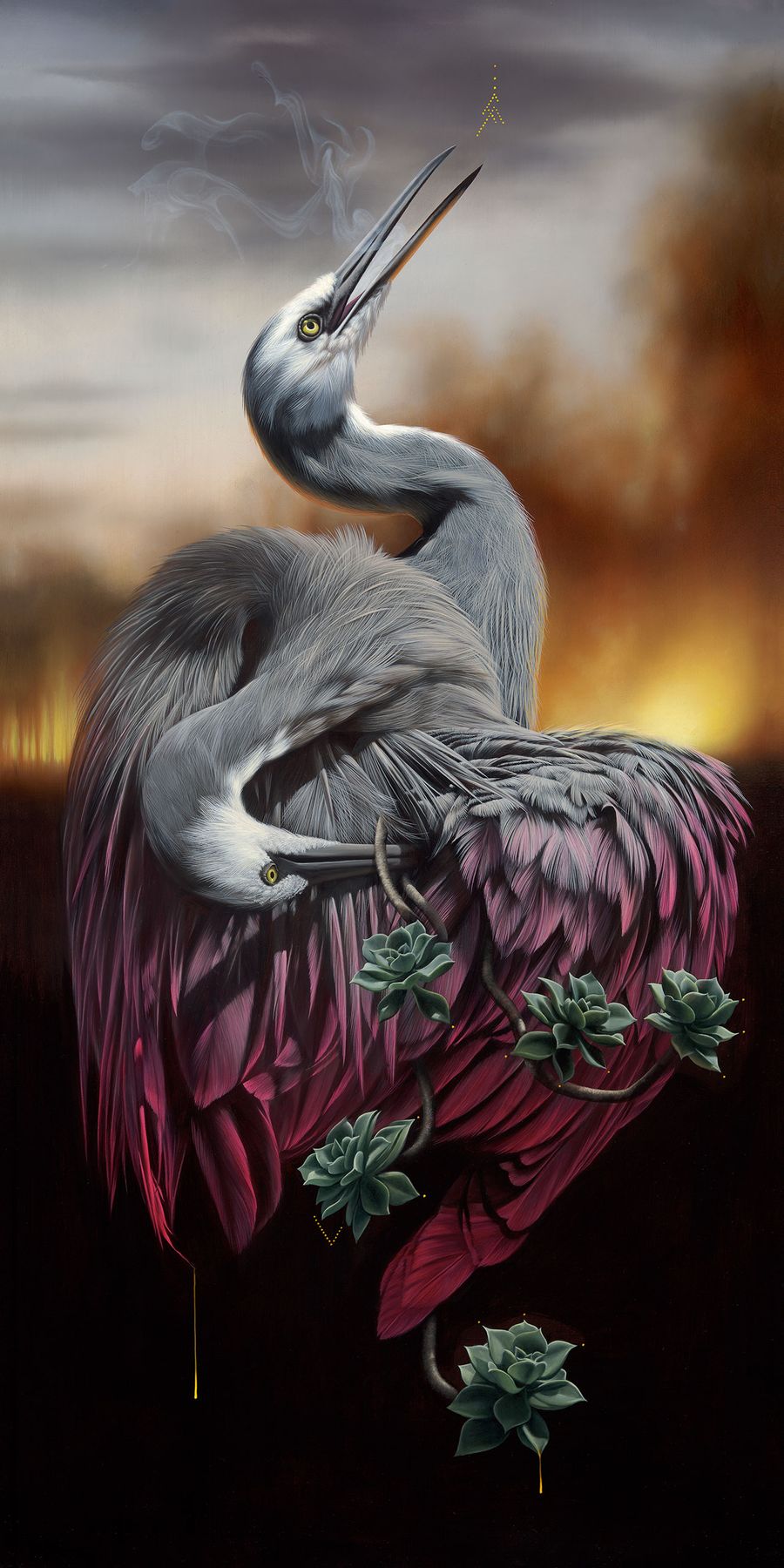
Josie Morway, Propagate, oil and enamel on wood panel. © Josie Morway.

Josie Morway, Ouroboros, oil and enamel on wood panel. © Josie Morway.

Josie Morway, Smoke, oil and enamel on wood panel. © Josie Morway.
There is something quite old-school, even ecclesiastical, in using oils and enamel on wood panels instead of canvas. Why did you choose this medium?
Now that I've established this way of working I do like that it suggests ancient practices, although I'm not using rabbit skin glue or grinding my own pigments like some painters do! But to be honest, my use of wood is just due to chance and youthful poverty. I was teaching myself to paint with oils in my early 20's and couldn't really afford art supplies, and one day I found a stack of pretty nice plywood panels on the side of the road. I took them home and painted on them, and that was that... I became attached to the hard surface, the way it supports detail and allows for manipulation - like scratching into the surface. Years later, I tried painting on one canvas and HATED it. It was so slippery, and it flexed under my hand, and I swore it off for good.
Many of your works are discretely adorned by cryptic geometric symbols and mysterious Latin text. What is their significance?
The main goal of my cryptic symbols is to feel cryptic and symbolic! That sounds flippant, but really, above all else I use the symbols and Latin to heighten the feeling of preciousness, to reference religious icons and other "serious" painting traditions, and to further elevate the natural subjects in my work. I always wait until the very last minute, when the painting is otherwise done, to stare at it for a while and decide what the meaning has turned out to be, what final touches the painting is asking for. Then I go looking for any words or symbols that will really tie up the whole piece.

Josie Morway, Symbiotes, oil and enamel on wood panel. © Josie Morway.
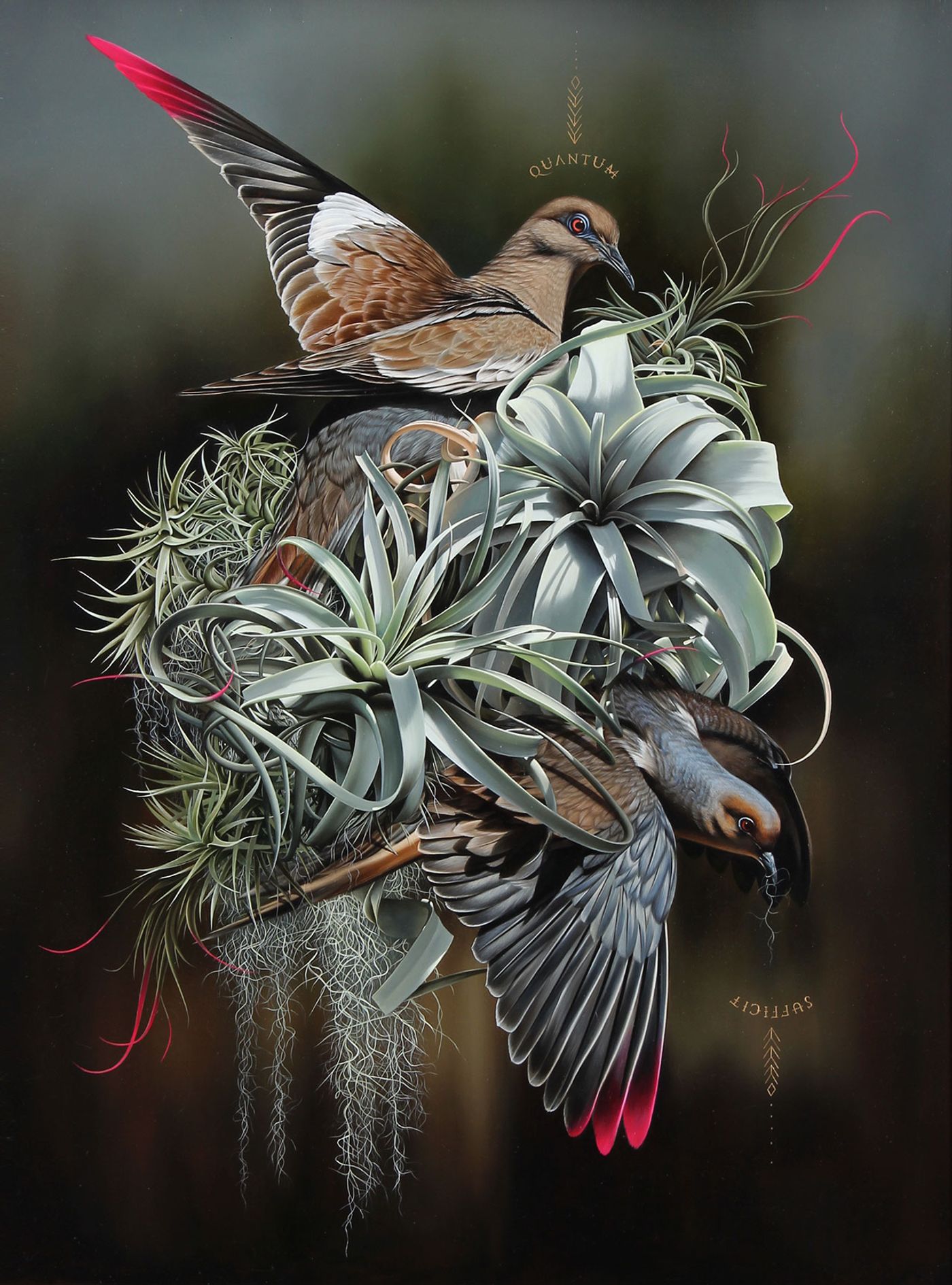
Josie Morway, Symbiotes II, oil and enamel on wood panel. © Josie Morway.
How has the digital age affected you as an artist? What are the advantages and disadvantages?
It's hard to sell paintings as it is, so I sometimes wonder if having easy access to pretty much all art online makes it even harder. Nevertheless, overall the internet has been amazingly positive for me. One reason in the sheer amount of visual references I can find and another is the fact that I no longer have to use a film camera to take slides of my work in order to share it with anyone. But far more crucial to me is the ability to communicate. A studio practice is a very solitary thing, and it's challenging to keep toiling away alone, especially with all of the doubts that are intrinsic to an art career: Why am I doing this? Does it mean anything? Does anyone care? Being able to share my work online and get immediate feedback, to have conversations with other artists and generally to feel seen during a studio day is invaluable to me. Sometimes I wonder if I'd have made it this far, and for this long, as a painter, if the internet hadn't come along to keep me company.
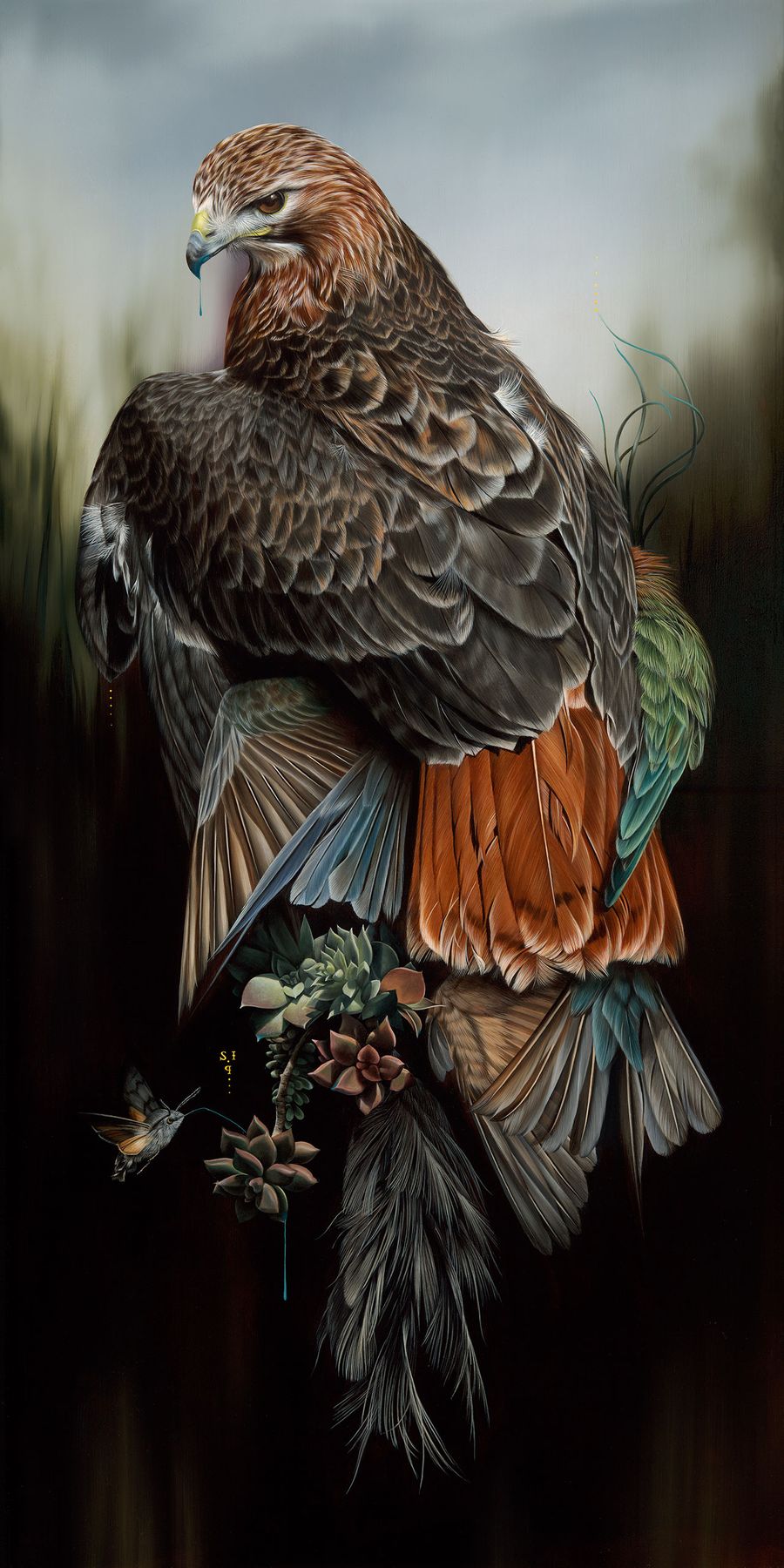
Josie Morway, Yield, oil and enamel on wood panel. © Josie Morway.
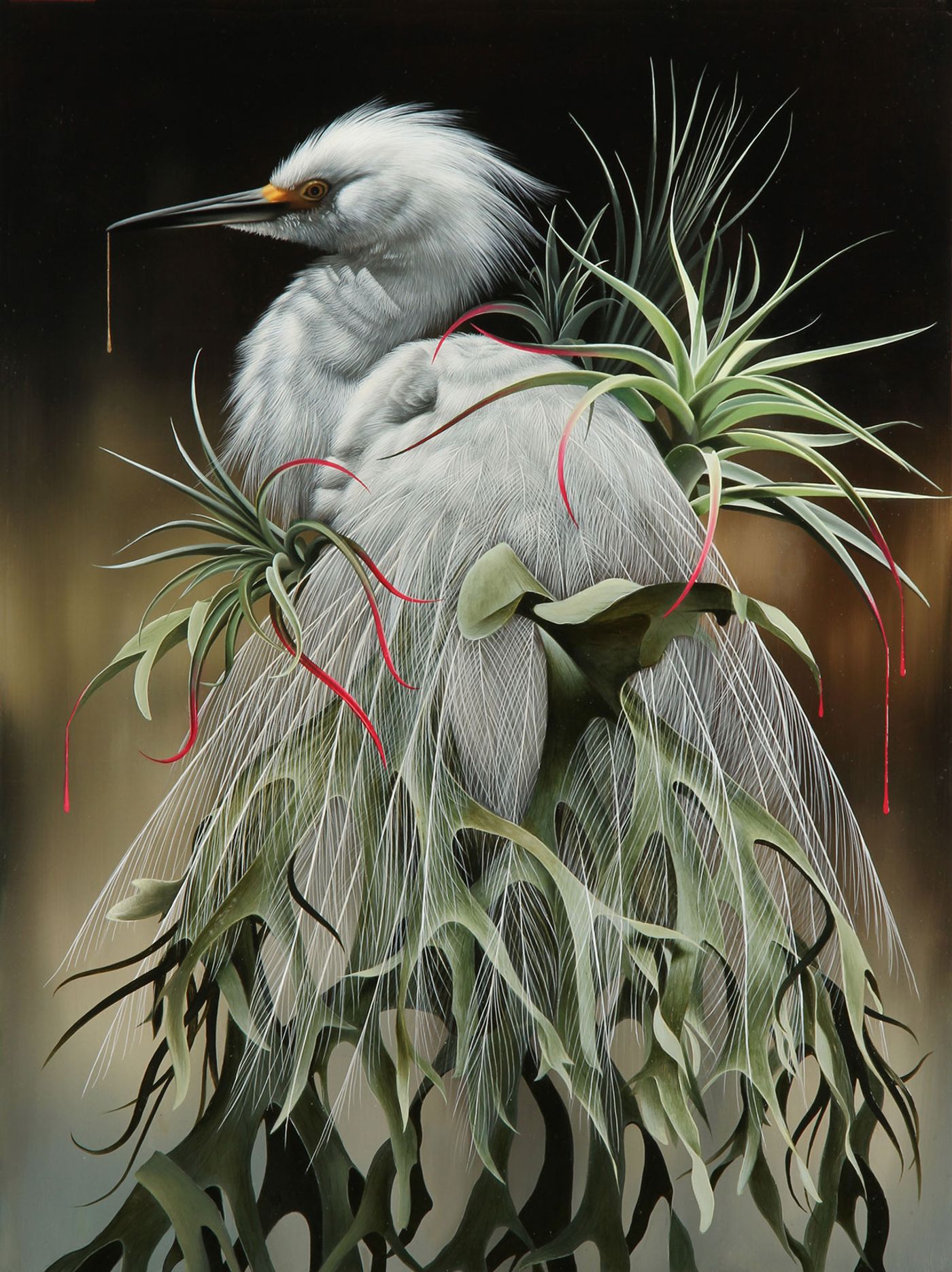
Josie Morway, Symbiotes III, oil and enamel on wood panel. © Josie Morway.
What are you working in right now? What are you future plans?
Right now I'm working on a few pieces for two group shows, Beinart Gallery's Small Works show , and a "postcard" show at StolenSpace, and I'll have work with Thinkspace at Scope Art in the fall. Then in October I'll have a two person show at Antler in Portland with my friend and artist Scott Listfield.I'd like to do more large bodies of work for solo shows, and to literally work larger as well, getting involved with more murals, challenging projects and collaborations. My hope is always that I'll be doing something in a year that I haven't even thought of yet, so hopefully I'll surprise you with something in the near future!
